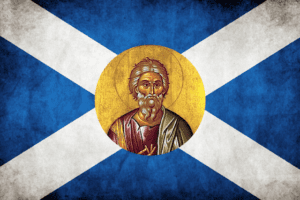

X
This site uses cookies. By continuing to use this site you agree to our use of cookies. To find out more, see our Privacy Policy and Cookie Policy.

With St Andrew’s Day just around the corner, we thought we’d take a look at who Saint Andrew was, how he became Scotland’s patron saint and the history behind the flag of Scotland.
Born around 5 AD in Bethsaida in Galilee, Saint Andrew went on to become one of the 12 disciples of Jesus Christ. Much like his younger brother, Simon Peter, Andrew was also a fisherman. In the Gospel of Matthew, it is said Jesus was walking along the shore of the Sea of Galilee and saw Andrew and Simon Peter fishing. It is then he asked the two to become disciples and “fishers of men.”
According to Tradition, A ndrew left the Holy Land after Pentecost to spread the Gospel in Greece and Asia Minor. In 60 AD, during the reign of Nero, he was working in Patras, where he baptized the wife and brother of the Governor, Aegeus. The Governor was so incensed by this, he ordered the death of the Apostle.
ndrew left the Holy Land after Pentecost to spread the Gospel in Greece and Asia Minor. In 60 AD, during the reign of Nero, he was working in Patras, where he baptized the wife and brother of the Governor, Aegeus. The Governor was so incensed by this, he ordered the death of the Apostle.
He was bound, rather than nailed, to a cross, as is described in the Acts of Andrew. He was crucified on a cross form known as “crux decussata,” which is an X-shaped cross or a “saltire.” Today this is commonly referred to as “St. Andrew’s Cross.” It is believed Andrew requested to be crucified this way, because he deemed himself “unworthy to be crucified on the same type of cross as Jesus.”
How did he become Scotland’s patron saint?
Some believe the bones of St Andrew were brought to Scotland several hundred years after his death with a new religious centre created at Kilrymont – which was then named St Andrews. Others believe he was named as patron saint of Scotland after Pictish King Oengus II led a victorious side against the Angles in East Lothian in 832 AD. The king believed he witnessed a divine intervention after seeing white clouds form a cross in the sky on the morning of the battle. He considered it to be a reference to the x-shaped cross where Andrew was crucified in Patras, Greece.
Whatever route the bones of Saint Andrew may have taken, we do know that in AD 908, the only bishopric in Scotland was transferred from Abernethy (the royal residence) to St. Andrews. Subsequently, the town rapidly became famous as a pilgrimage site. Saint Andrew is also the patron of Russia and Greece.
 History behind the Flag of Scotland
History behind the Flag of Scotland
The Saltire appears in Scottish history after in various forms. One of particular interest was in the 14th century where flags said to have been carried at the Battle of Otterburn in 1388, included a saltire on a sage green background.
By the start of the 16th century the plain white saltire on a blue field had become established. For instance, in 1511, the Great Michael, the largest warship of its day, was built for King James IV and carried the St Andrew’s Cross at its head, according to the Scottish Flag Trust. The official appearance of the Scottish flag was in 1542. It was a part of the illustration from the book “Register of Scottish Arms”, made by Sir David Lyndsay, a Scottish herald.
Some say that it’s the oldest flag in Europe. However, according to the official information, the flag of Scotland is the second-oldest national flag in the world, while the first place was proudly taken by Denmark’s “Dannebrog” (1478). It has been constantly changing since then – mainly because of the blue shades. The legend says that the St. Andrews cross represented the white wooden shade, while St. Andrews himself worn blue robes.
This led to a variety of colour choices – starting from light blue, indigo, and even dark navy. The sacred meaning of these colours is an important part of the Scottish flag. The white colour resembles pacification, while the blue colour is a symbol of justice.
Even though the blue flag with white X had lots of reviews, its appearance became standardized in 2003. The Scottish Parliamentary committee decided to invent a final version of the blue colour. The shade, known as Pantone 300, was chosen as the official background colour of the Scotland flag. This was highly requested by the Lord Lyon King of Arms and the petition from the Scottish Executive (government). The common proportions of the flag are 5:4.
Links
St. Andrew the Apostle – Saints & Angels – Catholic Online
Scottish Flag – History and Interesting Facts | Scotland.com